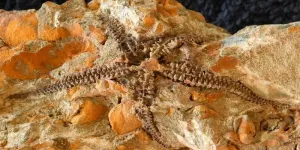(Press-News.org) When it comes to the architecture of the human genome, it’s only a matter of time before harmful genes — genes that could compromise future generations — arise in a population. These mutations accumulate in the gene pool, primarily affected by a population’s size and practices like marrying within a small community, according to researchers.
But much of the information about the effects of a population’s mutation load is based on genetic theory, with limited direct evidence concerning the effects on evolutionary fitness, or fertility.
New research from University of California, Davis, provides rare direct evidence showing that increased homozygosity — meaning two identical alleles in a genome — leads to negative effects on fertility in a human population. The paper was published Oct. 17 in the Proceedings of the National Academy of Sciences journal.
“People have known since Darwin that if you take people who are first cousins and they have children together, the children are more likely to develop certain diseases or be less healthy,” said Brenna Henn, an associate professor of anthropology in the College of Letters and Science at UC Davis.
The research assesses the consequences of homozygosity among Namibia’s Himba community, an isolated, agro-pastoralist population in which marriage between people with the same ancestor occurs. The research was led by Natalie Swinford, who received her doctoral degree in 2022 in evolutionary anthropology and human population genetics, and Henn.
“They’re what we call an ‘endogamous population,’ meaning people are meeting their partners just from within that Himba group,” said Henn. “They also have a unique system of marriage and reproduction, where men and women can have multiple boyfriends or girlfriends during their marriage. That means there are a lot of half-siblings in the population. That’s a unique feature and it means that we can leverage that social structure to look at different genetic effects.”
Echoes in the genome
In the study, the team gathered genetic data from 681 individuals from the Himba population. Genetic analyses revealed that the Himba have genetic markers that show higher levels of inbreeding.
Known as runs of homozygosity, or ROH, these markers are multiple and particularly long in the genomes of the analyzed Himba, which indicates that their parents had a high likelihood of sharing an ancestor.
While the Himba population has historically exhibited a preference for consanguinity, Henn and Swinford were surprised to find that none of the individuals in their sample population had parents who were actually first cousins. The lengths of the ROH in the genomes indicated otherwise.
The researchers found that these genetic effects can pool and accumulate over time. So, bottleneck events, like a decrease in population that leads to inbreeding, can have genetic echoes that don’t manifest until generations later. The researchers concluded that such events occurred within the past 12 to 18 generations of the Himba population.
“People may not be full first-cousins,” Henn said. “But they may be half-cousins once removed and then their grandparents might have been half-cousins. Anytime something like that happens, it’s going to contribute to there being identical DNA in the offspring.”
A negative effect on fertility
The Himba are a pronatalist community, meaning they encourage their members to have many children. Typically, there are short intervals between births, roughly between one and three years, researchers said.
To gauge the effects of long ROH on fertility, the researchers measured the reproductive success of post-reproductive women in their sample population. The researchers defined reproductive success as the number of children who survived to at least 5.
The research team used statistical models to analyze the relationship between the amount of ROH in the genome and the number of children a woman had. They found that the greater the proportion of the genome that was in ROH, the more likely a woman was to have fewer children than a woman who had less ROH.
“This means that a woman who has parents who are more related is more likely to have fewer children throughout her lifetime than a woman who has parents who are less related,” said Swinford.
Contributing authors on the paper include S.P. Prall, University of Missouri; S. Gopalan, Duke University; C.M. Williams, Brown University; J. Sheehama, University of Namibia; and B.A. Scelza, University of California, Los Angeles.
END
New Haven, Conn. — When Yale neuroscientist Joy Hirsch used sophisticated imaging tools to track in real time the brain activity of two people engaged in conversation, she discovered an intricate choreography of neural activity in areas of the brain that govern social interactions. When she performed similar experiments with two people talking on Zoom, the ubiquitous video conferencing platform, she observed a much different neurological landscape.
Neural signaling during online exchanges was substantially suppressed compared to activity observed ...
In the 2009 film "Gifted Hands," based on a true story, the audience follows Black neurosurgeon Dr. Ben Carson as he successfully performs three risky surgeries, earning praise from the media and medical community. This movie was not only a hit with critics and audiences, but it also inspired Bismarck Christian Odei, MD, an assistant professor in radiation oncology at Huntsman Cancer Institute at the University of Utah, to follow his passion.
“Seeing a physician who looked like me, ...
Law enforcement officers in the United States own firearms at high rates and rarely engage in secure firearm storage, which could increase their risk for suicide, according to a Rutgers study.
The researchers, whose study appears in the journal Injury Prevention, examined data from 369 law enforcement officers in the U.S. Information about firearm ownership, storage, suicide risk and demographics were included in the present study.
Overall, 70.5 percent of law enforcement officers report owning a firearm. The most common type of firearms owned were handguns (79.7 percent) followed by shotguns (61.1 percent) and rifles (57.5 percent). A sharp majority, 78.9 percent, ...
New research from Japan published in the Ecological Society of America’s journal Ecology suggests that increasingly severe weather driven by climate change may push oceangoing seabirds to their limits.
In August 2019, Kozue Shiomi, a seabird biologist at Tohoku University, attached GPS bio-loggers to 14 adult streaked shearwaters (Calonectris leucomelas) from a nesting colony on Mikurajima, a small island near Tokyo, as part of a study on the species homing behavior.
In September of that same year, an exceptionally powerful storm, Typhoon Faxai, barreled into southeastern Japan, causing considerable physical damage to the mainland. But the typhoon, ...
DENVER/Oct. 25, 2023 – A recently published paper in Animal Conservation provides crucial insights into the health of sihek, a species eradicated from its native habitat and that may now face threats in captivity. The latest data underscores a stark gender disparity, revealing that female sihek are at greater risk for death and disease than their male counterparts.
As part of an ongoing Morris Animal Foundation-funded study, researchers at The Zoological Society ...
INDIANAPOLIS — It’s no secret that a good night’s rest can do wonders for one’s health, but those who struggle with insomnia have a nearly 50% increased risk of cardiovascular disease. One scientist in the School of Science at IUPUI will spend the next five years trying to figure out how those risks can be reduced.
Jesse Stewart, a professor of psychology at the school, has received a five-year, $3 million grant from the National Institutes of Health’s National Heart, Lung and Blood Institute for a project named the Strengthening Hearts ...
EMBARGOED FOR RELEASE UNTIL 4 P.M. ET, WEDNESDAY, OCTOBER 25, 2023
MINNEAPOLIS – Older people who have higher levels of triglycerides, a type of fat, may have a lower risk of dementia and a slower cognitive decline over time compared to people who have lower levels, according to new research published in the October 25, 2023, online issue of Neurology®, the medical journal of the American Academy of Neurology. While the study found a link, it does not prove that higher levels of triglycerides prevent dementia.
Triglycerides are fatty acids and are the most common type of fat in the blood. Triglycerides contribute ...
EMBARGOED FOR RELEASE UNTIL 4 P.M. ET, WEDNESDAY, OCTOBER 25, 2023
MINNEAPOLIS – People who have experienced traumatic events in childhood such as abuse, neglect or household dysfunction may be more likely to experience headache disorders as adults, according to a meta-analysis published in the October 25, 2023, online issue of Neurology®, the medical journal of the American Academy of Neurology. This research does not prove that such experiences cause headaches; it only shows an association.
“Traumatic events in childhood can have ...
Brittle star fossils found in South Africa are over 410 million years old, the oldest known examples who lived at high latitude
###
Article URL: https://journals.plos.org/plosone/article?id=10.1371/journal.pone.0292636
Article Title: Earliest known ophiuroids from high palaeolatitude, southern Gondwana, recovered from the Pragian to earliest Emsian Baviaanskloof Formation (Table Mountain Group, Cape Supergroup) South Africa
Author Countries: South Africa, Luxembourg
Funding: RWG: Millennium Trust, South Africa (no number). https://www.mtrust.co.za ...
In a study of different types of distraction involving more than 1,000 participants, researchers statistically derived a novel measure—dubbed the “d factor”—that could represent a person’s general tendency towards distraction and may be linked with attention-deficit/hyperactivity disorder (ADHD). Han Zhang of the University of Michigan, Ann Arbor, and colleagues present these findings in the open-access journal PLOS ONE on October 25, 2023.
Prior research has explored various types of distraction, such as external stimulations, repetitive ...





